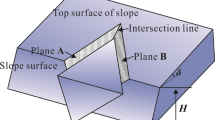Abstract
In a probabilistic analysis of rock slope stability, the Monte Carlo simulation technique has been widely used to evaluate the probability of slope failure. While the Monte Carlo simulation technique has many advantages, the technique requires complete information of the random variables in stability analysis; however, in practice, it is difficult to obtain complete information from a field investigation. The information on random variables is usually limited due to the restraints of sampling numbers. This is why approximation methods have been proposed for reliability analyses. Approximation methods, such as the first-order second-moment method and the point estimate method, require only the mean and standard deviation of the random variable; therefore, it is easy to utilize when the information is limited. Usually, a single closed form of the formula for the evaluation of the factor of safety is needed for an approximation method. However, the commonly used stability analysis method of wedge failure is complicated and cumbersome and does not provide a simple equation for the evaluation of the factor of safety. Consequently, the approximation method is not appropriate for wedge failure. In order to overcome this limitation, a simple equation, which is obtained from the maximum likelihood estimation method for wedge failure, is utilized to calculate the probability of failure. A simple equation for the direct estimation of the safety factors for wedge failure has been empirically derived from failed and stable cases of slope, using the maximum likelihood estimation method. The developed technique has been applied to a practical example, and the results from the developed technique were compared to the results from the Monte Carlo simulation technique.



Similar content being viewed by others
References
Alonso EE (1976) Risk analysis of slopes and its application to slopes in Canadian sensitive clays. Géotechnique 26:453–472
Babu GLS, Mukesh MD (2003) Risk analysis of landslides––a case study. Geotech Geol Eng 21:113–127
Babu GLS, Singh V (2009) Reliability analysis of soil nail wall. Georisk 3(1):44–54
Baecher GB, Christian JT (2003) Reliability and Statistics in Geotechnical Engineering. John Wiley & Sons, London
Cherubini C (2000) Reliability evaluation of shallow foundation bearing capacity on c, φ soils. Can Geotech J 37:264–269
Cho SE, Park HC (2010) Effect of spatial variability of cross-correlated soil properties on bearing capacity of strip footing. Int J Numer Anal Methods Geomech 34:1–26
Christian JT, Ladd CC, Baecher GB (1994) Reliability and probability in stability analysis. J Geotech Eng ASCE 120:1071–1111
Duncan JM (2000) Factors of safety and reliability in geotechnical engineering. J Geotech Geoenviron Eng ASCE 126(4):307–316
El-Ramly H, Morgenstern NR, Cruden DM (2002) Probabilistic slope stability analysis for practice. Can Geotech J 39:665–683
Harr ME (1987) Reliability based on design in civil engineering. McGraw-Hill, New York
Hoek ET, Bray JW (1981) Rock slope engineering. Institute of Mining and Metallurgy, London
Kim H, Major G (1978) Application of Monte Carlo techniques to slope stability analyses. Proceedings of 19th US Symposium on Rock Mechanics, Nevada, pp 28–38
Low BK, Tang WH (1997) Reliability analysis of reinforced embankments on soft ground. Can Geotech J 34:672–685
Lumb P (1970) Safety factors and the probability distribution of soil strength. Can Geotech J 7:225–242
Mostyn GR, Li KS (1993) Probabilistic slope stability analysis––state-of-play.In: Li KS, Lo, S-CR, Balkema AA (eds) Probabilistic methods in geotechnical engineering. Rotterdam, pp 89–109
Muralha J (1991) A probabilistic approach to the stability of rock slope. In: Balkema AA (ed) 7th Congress of the International Society for Rock Mechanics (ISRM), Germany, pp 921–927
Muralha J, Trunk U (1993) Stability of rock blocks evaluation of failure probabilities by Monte Carlo simulation and first order reliability methods. In: Balkema AA (ed) International Symposium on Assessment and Prevention of Failure Phenomena in Rock Engineering, pp 759–765
Nexgeo (2003) Preliminary geological investigation on dam site, Gunwi-gun, Gyeongsangbuk-do (in Korean)
Nguyen VU, Chowdhury RN (1984) Probabilistic study of spoil pile stability in strip coal mines––two techniques compared. Int J Rock Mech Min Sci Geomech 21:303–312
Nilsen B (2000) New trend in rock slope stability analysis. Bull Eng Geol Environ 58:173–178
Norrish NI, Wyllie DC (1996) Rock slope stability analysis. In: Turner AK, Schuster RL (eds) Landslides; investigation and mitigation. National Academy Press, Washington, pp 391–425
Park HJ, West TR (2001) Development of a probabilistic approach for rock wedge failure. Eng Geol 59:233–251
Park HJ, Woo I, West TR (2005) Probabilistic analysis of rock slope stability and random property parameters, Interstate Highway 40, Western North Carolina. Eng Geol 79:230–250
Pathak S, Nilsen B (2004) Probabilistic rock slope stability analysis for Himalayan condition. Bull Eng Geol Environ 63:25–30
Phoon KK, Kulhawy FH (1999) Characterization of geotechnical variability. Can Geotech J NRC 36(4):612–624
Rethai L (1998) Probabilistic solutions in geotechnics. Amsterdam, Elsevier
Rosenblueth E (1975) Point estimates for probability moments. Proc Natl Acad Sci 72:10
Sah NK, Sheorey PR, Upadhyaya LN (1994) Maximum likelihood estimation of slope stability. Int J Rock Mech Min Sci Geomech Abstr 31:47–53
Schultze E (1975) The general significance of statistics for the civil engineer. Proceedings of the 2nd International Conference on Application of Statistics and Probability in Soil and Structural Engineering, Aachen
Yucemen MS, Tang WH, Ang AHS (1973) A probabilistic study of safety and design of earth slopes. Civil engineering studies, structural research series, vol 402. University of Illinois, Champaign
Acknowledgments
This work was supported by the National Research Foundation of Korea (NRF) grant funded by the Korea government (MEST) (No. 2010-0028025) and ETI II project, “Development of Reservoir Characterization and Monitoring Systems for an Optimal Production from Unconventional Reservoirs”.
Author information
Authors and Affiliations
Corresponding author
Rights and permissions
About this article
Cite this article
Park, H.J., Um, JG., Woo, I. et al. The evaluation of the probability of rock wedge failure using the point estimate method. Environ Earth Sci 65, 353–361 (2012). https://doi.org/10.1007/s12665-011-1096-7
Received:
Accepted:
Published:
Issue Date:
DOI: https://doi.org/10.1007/s12665-011-1096-7




